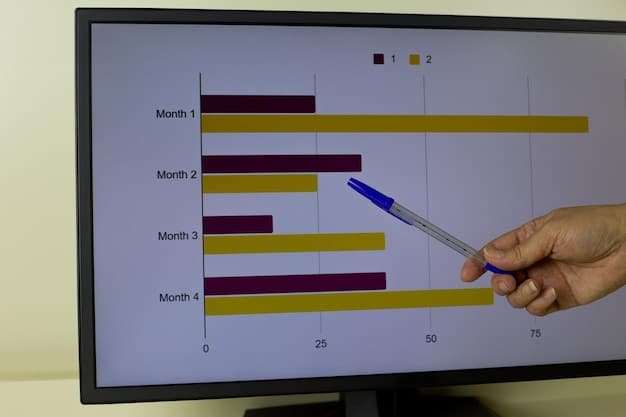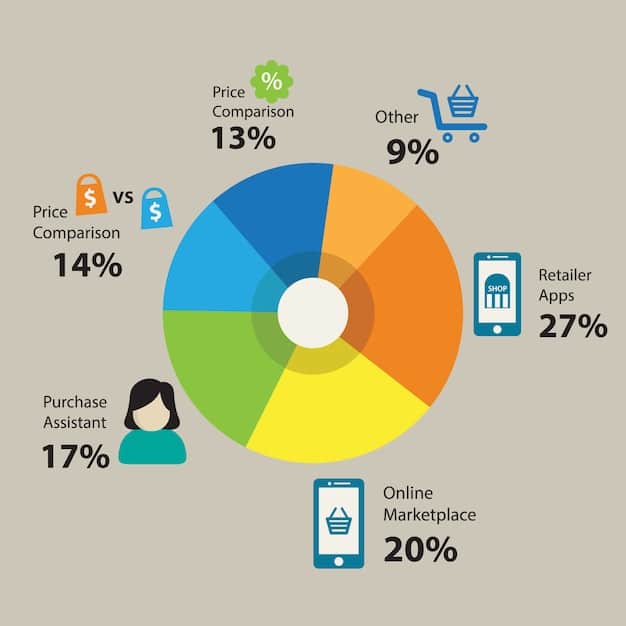Streaming Bundles in the US: Are You Really Saving Money?

Streaming bundles in the US offer the allure of cost savings by combining multiple services, but a data-driven analysis reveals that the actual financial benefit depends heavily on individual viewing habits, bundle composition, and a thorough comparison against à la carte subscriptions.
Are streaming bundles in the US: Are You Really Saving Money? A Data-Driven Analysis actually worth the hype? Let’s dive deep into the numbers.
Understanding Streaming Bundles: The Basics
Streaming bundles are packages that combine multiple streaming services into a single subscription. The idea is to offer convenience and potential cost savings.
But are these bundles truly a better deal than subscribing to each service individually? Let’s explore the basics.
What’s Included in a Typical Streaming Bundle?
A typical streaming bundle may include a mix of video streaming services, music streaming, and sometimes even other digital services.
- Video Streaming: This is the most common component, often featuring popular platforms like Netflix, Hulu, Disney+, and HBO Max.
- Music Streaming: Some bundles include access to services like Spotify or Apple Music.
- Other Digital Services: Certain bundles might throw in perks like cloud storage, news subscriptions, or even mobile phone plans.
The specific combination of services varies widely from bundle to bundle.
In conclusion, streaming bundles offer a convenient way to access multiple services, but it’s crucial to understand what’s included before deciding if it’s the right choice.
The Allure of Bundled Streaming Services
The appeal of streaming bundles stems from the perceived value of getting more for less. Bundling creates the illusion of savings.
But let’s examine the psychological and economic factors driving the popularity of these bundles.
Psychological Factors: The “Deal” Mindset
Consumers are often drawn to bundles because they perceive them as a “deal.” The thought process is that you’re getting multiple services for a lower price than if you purchased them separately.
This is an example of the classic “anchoring bias,” where the bundled price serves as an anchor, making the individual prices seem more appealing.
Economic Factors: Potential Cost Savings
From an economic standpoint, bundles can indeed offer cost savings, but only if you actually use all the services included in the bundle. If you’re paying for services you don’t use, the bundle becomes less economical.
It’s essential to evaluate your usage patterns and compare the cost of the bundle to the cost of subscribing to only the services you truly need.

Ultimately, the allure of streaming bundles lies in the perception of value and the potential for cost savings, but it’s crucial to assess your own usage habits to ensure you’re truly getting a good deal.
Data-Driven Analysis: Are Bundles Really Cheaper?
To determine if streaming bundles are truly cheaper, a data-driven analysis is necessary. This involves comparing the cost of bundles with the cost of individual subscriptions.
Let’s crunch the numbers and see what the data reveals.
Comparing Bundle Costs vs. Individual Subscription Costs
We need to compare the price of popular streaming bundles against the cost of subscribing to each service individually.
- First, compile a list of popular streaming bundles available in the US market.
- Next, identify the individual services included in each bundle and their respective subscription costs.
- Finally, compare the total cost of the bundle against the combined cost of the individual subscriptions.
Analyzing Common Streaming Bundles in the US
Several streaming bundles are available in the US, each offering a different mix of services and pricing structures. Let’s analyze a few common examples.
For instance, consider a bundle that includes Netflix, Hulu, and Spotify. Compare the combined cost of subscribing to each of these services individually against the price of the bundle. If the combined individual cost is higher, the bundle offers a cost savings. However, if you only use two of the three services, subscribing individually might be cheaper.

In conclusion, a data-driven analysis is essential to determine if streaming bundles are truly cheaper. By comparing the cost of bundles with the cost of individual subscriptions, you can make an informed decision about which option is best for your needs.
Hidden Costs and Considerations of Streaming Bundles
While streaming bundles may seem like a straightforward way to save money, there are hidden costs and considerations to keep in mind. These factors can impact the overall value of the bundle.
Let’s delve into these often overlooked aspects.
Data Caps and Internet Speed
Streaming consumes a significant amount of data, and if you have a data cap on your internet plan, using multiple streaming services could lead to overage charges. Similarly, if your internet speed is slow, streaming multiple services simultaneously might result in buffering or poor video quality.
Consider this: Many ISPs offer streaming bundles as part of their service packages. While seemingly convenient, these bundles may incentivize you to use more data, potentially leading to higher bills in the long run due to overage fees.
Service Overlap and Unused Content
Another hidden cost is service overlap. Some bundles may include services that offer similar content, leading to redundancy. Additionally, you might be paying for services within the bundle that you rarely or never use.
Before committing to a bundle, carefully assess the content libraries of each service and determine if there’s significant overlap. Also, consider your viewing habits. Are you likely to use all the services included in the bundle, or will you only be using a few?
In summary, while streaming bundles can offer potential cost savings, it’s important to be aware of hidden costs and considerations such as data caps, internet speed, service overlap, and unused content. Thoroughly evaluate these factors before making a decision.
Strategies for Maximizing Savings with Streaming Bundles
If you’ve decided that a streaming bundle is right for you, there are strategies you can use to maximize your savings. These strategies involve carefully choosing the right bundle and optimizing your usage.
Let’s explore these techniques.
Choosing the Right Bundle for Your Needs
The key to maximizing savings with streaming bundles is to choose a bundle that aligns with your viewing habits and preferences. Don’t be swayed by bundles that include services you’re unlikely to use.
Consider your favorite TV shows, movies, and music. Identify the streaming services that offer the content you enjoy, and then look for bundles that include those services. Also, think about the number of users in your household. Some bundles offer multiple user profiles, while others are limited to a single user.
Optimizing Usage Across Different Services
Once you’ve chosen a bundle, optimize your usage across the different services to get the most value for your money. This involves actively seeking out content on all the services included in the bundle.
Explore the content libraries of each service and make a list of shows, movies, and music you want to watch or listen to. Set aside time each week to enjoy content on different services. By diversifying your usage, you’ll avoid paying for services you rarely use.
In conclusion, by carefully choosing the right bundle and optimizing your usage across different services, you can maximize your savings and get the most value for your money.
Future Trends in Streaming Bundles
The streaming landscape is constantly evolving, and streaming bundles are likely to change as well. Several future trends are shaping the direction of these bundles.
Let’s take a look at what the future holds.
Personalized Bundles and AI-Driven Recommendations
One trend is the rise of personalized bundles. Instead of offering a fixed set of services, streaming providers may allow users to create their own custom bundles based on their individual preferences. This would enable users to pay only for the services they actually want, potentially leading to greater cost savings.
AI-driven recommendations could also play a role. Streaming providers could use AI to analyze viewing habits and recommend bundles that align with user preferences. This would make it easier for users to find the right bundle without having to manually compare different options.
Integration with Other Services (e.g., Gaming, Fitness)
Another trend is the integration of streaming bundles with other services, such as gaming and fitness. For example, a bundle could include access to video streaming, music streaming, and a cloud gaming service. This would offer a more comprehensive entertainment package.
Fitness streaming could also be included. Bundles may offer access to workout videos and personalized fitness plans, providing a more holistic wellness package.
In summary, the future of streaming bundles is likely to be shaped by personalized offerings, AI-driven recommendations, and integration with other services like gaming and fitness.
| Key Point | Brief Description |
|---|---|
| 🤔 Bundle Value | Bundles offer value only if you use most included services. |
| 💰 Hidden Costs | Data caps, slow internet, and unused services can negate savings. |
| ✅ Max Savings | Choose bundles matching your viewing habits and optimize usage. |
| 🔮 Future Trends | Personalized bundles and integration with gaming/fitness are emerging. |
Frequently Asked Questions
▼
Not necessarily. It depends on whether you use all the services included in the bundle. If you only use a few, individual subscriptions might be more cost-effective.
▼
Common bundles include those from major providers like Disney (Disney+, Hulu, ESPN+) and telecom companies offering bundled streaming with internet or mobile plans.
▼
Assess your viewing habits, identify the services you use most, and compare the bundle price to the cost of subscribing to those services individually.
▼
Yes, potential hidden costs include data caps, slow internet speeds, service overlap, and paying for services you rarely use.
▼
Expect personalized bundles, AI-driven recommendations, and integration with other services like gaming and fitness to become more prevalent.
Conclusion
Ultimately, the decision of whether to opt for streaming bundles requires careful consideration. Analyze your viewing habits, compare costs, and be aware of hidden expenses to determine if a bundle truly saves you money.





